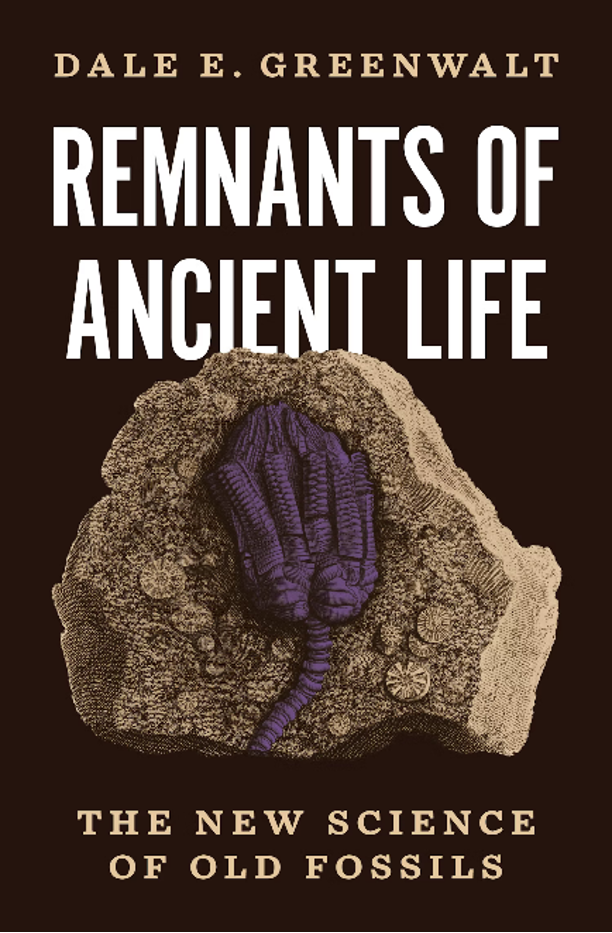Reviewed by Christa Cherava (National Parks Conservation Association, USA)

Greenwalt, D. 2023. Remnants of Ancient Life: The New Science of Old Fossils. Princeton University Press, Princeton, NJ. 288 pp. ($22.36 cloth, $19.57 e-book with 20% PS discount.)
The author, Dale Greenwalt, is a research associate for the Smithsonian Institution’s National Museum of Natural History where he curates the Kishenehn Formation (northern Montana) fossil insect collection. It is here where the idea for this book originated through citizen science. Amateurs found a fossilized mosquito, filled with blood, and 46 million years old. Eventually this led to a quest to share complex information about the area of science that seeks to find and understand ancient biomolecules. Although in its infancy, as oftentimes reiterated, paleobiology is gaining ground. Where it once had to rely solely on comparative anatomy to classify specimens, it is now able to increase its accuracy by the ability to examine the molecular building blocks of life that are contained in ancient remains and distinguished by deep time.
Greenwalt quickly moves on from using insects as the main example for biomolecular research. In the chapters that follow, he incorporates a myriad of other subjects including plants and their lack of ancient DNA; dinosaurs; mammals from the Pleistocene; bubonic plague and other bacteria; examples from archaeology and anthropology—spanning Otzi and the Egyptian pharaohs, to Neandertals and other hominins; and so much more. In doing so, he presents their associated ancient molecules: cellulose, lignin, chitin, pigments, cholesterol, melanin, keratins, biometals, and proteomes—subsets of a protein that are specific to an organ, etc. They range in age from thousands of years to hundreds of millions of years. The obvious point being that the sources and locations of such evidence seem limitless.
Important to the overall theme here is that ancient biomolecules by themselves are quite common—atmospheric oxygen (2.4B years old!) and the fossil fuels we use today that were naturally developed from decomposing plants. The difference in the examples that Greenwalt provides in this book, is that he focuses on biomolecules that are preserved in situ and emphasizes the reason it is necessary to find this material in the fossil in its original setting. Knowing the anatomical context allows scientists to understand the function associated with it. It is the ancient biomolecule that leads us to learn about the phylogenetic, behavioral, and physiological aspects. Without these surroundings, so much of the story is lost—essentially incomplete, and the biomolecules then become referred to as biomarkers.
Like any credible book based on and intentionally written about science, this one is filled with deliberately chosen facts and statistics within each example explored. Ages of the biomolecules or their first appearances on the planet using the molecular clock; stories of the first scientists credited with the cited work and the current debates among the scientific community; the lessons learned only after making major mistakes in the lab; the ethics of such studies; and the notion that scientific discoveries don’t just answer a question—they end up requiring many more to be asked. Spoiler alert! Anyone who wants to know if the rumor is true—can an ancient organism, in its entirety, be recreated with science now? No. But individual functional components are among the first to be reproduced; so when, if ever, will all these parts equal a whole ancient organism?
I recommend this book for anyone who is intrigued by paleontology in general, but also wants to learn more about its scientific significance on a much deeper level. This “new science” serves to answer the specifics that paleontologists ask. Although Greenwalt weaves in the definitions of relevant terms and basic principles of geology and paleontology, the reader should have a solid understanding of introductory chemistry and biology to fully grasp the methods used to extract the biomolecules and the full extent of why these findings are so substantial. Paleontology really is multidisciplinary. And because of my job, I didn’t miss the mention of national parks and protected areas throughout this book! These places and resources are guarded for a reason and I’m hoping these areas yield more fascinating discoveries.
The book doesn’t conclude with some thought-provoking statement, nor does it leave the reader with a reflective question to ponder long after they close it shut. It doesn’t need to—the entire book contains those elements embedded throughout. At best—it will leave the reader in complete awe of the potential that this planet possesses in terms of preservation techniques and the information that is still viable millions of years later under the rarest conditions. At a minimum, one will never be able to look at fossils the same way again. This isn’t just a compilation of the studies and successes, or the descriptions of technological procedures used to render the insight. This book introduces the reader to the possibilities based on just the beginning of these understandings. What could be next?

